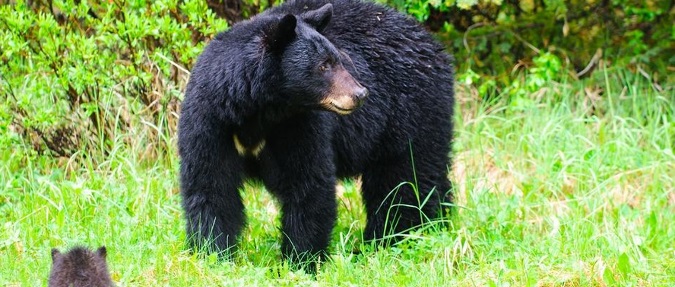
To tell why black bears have flourished in Pennsylvania, Game Commission biologist Mark Ternent recounted the life of the state’s oldest bear, which was 36 when discovered by a Carbon County homeowner in 2013.
During the lifespan of that single bear, the number of bears in Pennsylvania zoomed from 5,000 to 15,000, and biologists like Ternent changed the priorities from boosting the population to reducing conflicts between people and bears.
When the bear was a yearling, the population was so low that the Game Commission canceled hunting seasons in 1977 and 1978 and limited the season to one day in 1979.
In 1980, the commission required hunters to buy separate licenses for bears. Many didn’t spend the extra money, so the number of hunters plummeted from 250,000 to around 100,000.
Also, the commission closed counties with few bears in southwestern Pennsylvania to hunting from 1980 to 1987. Into those areas, the commission transferred pregnant sows from areas with large numbers of bears such as the Poconos and northcentral Pennsylvania.
After those changes happened, bears took advantage of Pennsylvania’s natural features to thrive.
Forests leveled for timber and leather tanning by the 1920s had regrown, so bears had shelter and food.
Abundance for bruins
Bears eat a variety of foods, including plants and insects in spring, berries in summer and beechnuts and acorns in autumn.
The food supply in Pennsylvania allows black bears to reach 100 pounds, the weight sows need to reach before starting to reproduce, at 2½ years, which is earlier than most other states and Canadian provinces, Ternent said during a talk about bears in September at Penn State Wilkes-Barre.
In Pennsylvania, about a quarter of bears have four cubs and the average litter of three bears exceeds that in other states.
Now, Pennsylvania has close to 20,000 bears, spread across three-fourths of all counties. There are no signs, such as smaller litters or lower rates of cub survival, to suggest that the forests, fields and swamps have reached their capacity to support more bears.
Rather, the population approached what Ternent called the cultural carrying capacity.
While Pennsylvanians reported fewer than 50 complaints about nuisance bears in the mid-1980s, annual complaints exceeded 250 by the 2000s.
To reduce clashes and motor vehicle crashes involving bears, the commission now starts the rifle bear season on a Saturday, when more hunters can participate, instead of a Monday. The commission also expanded the season by allowing hunters in many regions to take bears during the first days of the rifle deer season.
Hibernation
By the approach of hunting seasons, bears have already mated and are about to find dens for hibernating.
Some females hibernate before hunters go afield, but virtually no males sleep through hunting season, Ternent said.
While in dens, bears don’t eat, drink or expel wastes, yet they remain aware enough that if poked they could run away or defend their cubs.
Bears mate in June and July, but the fertilized eggs don’t start developing for months, Ternent said while describing their delayed fertilization. If the sow finds food and reaches an adequate weight, the embryo attaches to the uterus and begins developing by late October or early November. During lean years, however, embryos die so the sow can get pregnant the next year.
With little time to develop, cubs are born small, blind and hairless.
But in two weeks after birth, they grow from about 10 ounces to 10 pounds before they leave the den.
They fill out by drinking mother’s milk, which has a fat content of 30 percent.
“We feel guilty about drinking two percent. Imagine drinking 30 percent,” Ternent said.
Cubs stay with mothers for a year and a half so sows have litters every other year. Yearling males wander before establishing a home range of 20 square miles. Females usually choose a home range of 6 to 8 square miles near the home range of their mothers.
PA’s oldest bear
The oldest bear, Ternent mentioned, avoided hunters and vehicles, but not commission trackers. They trapped the bear twice in the summer of 1982 when it was 6 and placed a tag in its ear before releasing it.
When game officers found the record-setting bear again in Kidder Township on Nov. 8, 2011, it weighed 275 pounds, 150 pounds more than when it was first trapped. They euthanized the bear because it couldn’t walk. It was eight weeks shy of its 37th birthday. Ternent said bears 20 years or older are harvested every few years, and every year’s harvest includes bears that are 14 or older.
Each year, the game commission workers tag 600 bears. During hunting season, they count how many tagged bears appear in the harvest to estimate mortality rates and population totals.
The Game Commission checks the weight and age of all harvested bears by pulling a tooth, which has age rings like those of a tree trunk.
Results from the check stations show that hunters are taking large bears and large numbers of bears.
Six bears hunted between 1992 and 2008 weighed more than 800 pounds.
In eight of the past 10 years, the number of bears harvested made the all-time, top-10 list.
But that doesn’t make the task easy for the 175,000 hunters who pursue them.
Only two percent of hunters each year bring home a bear.
